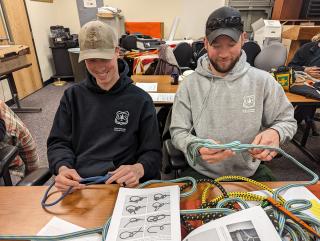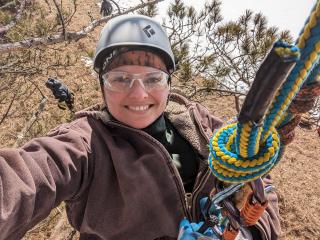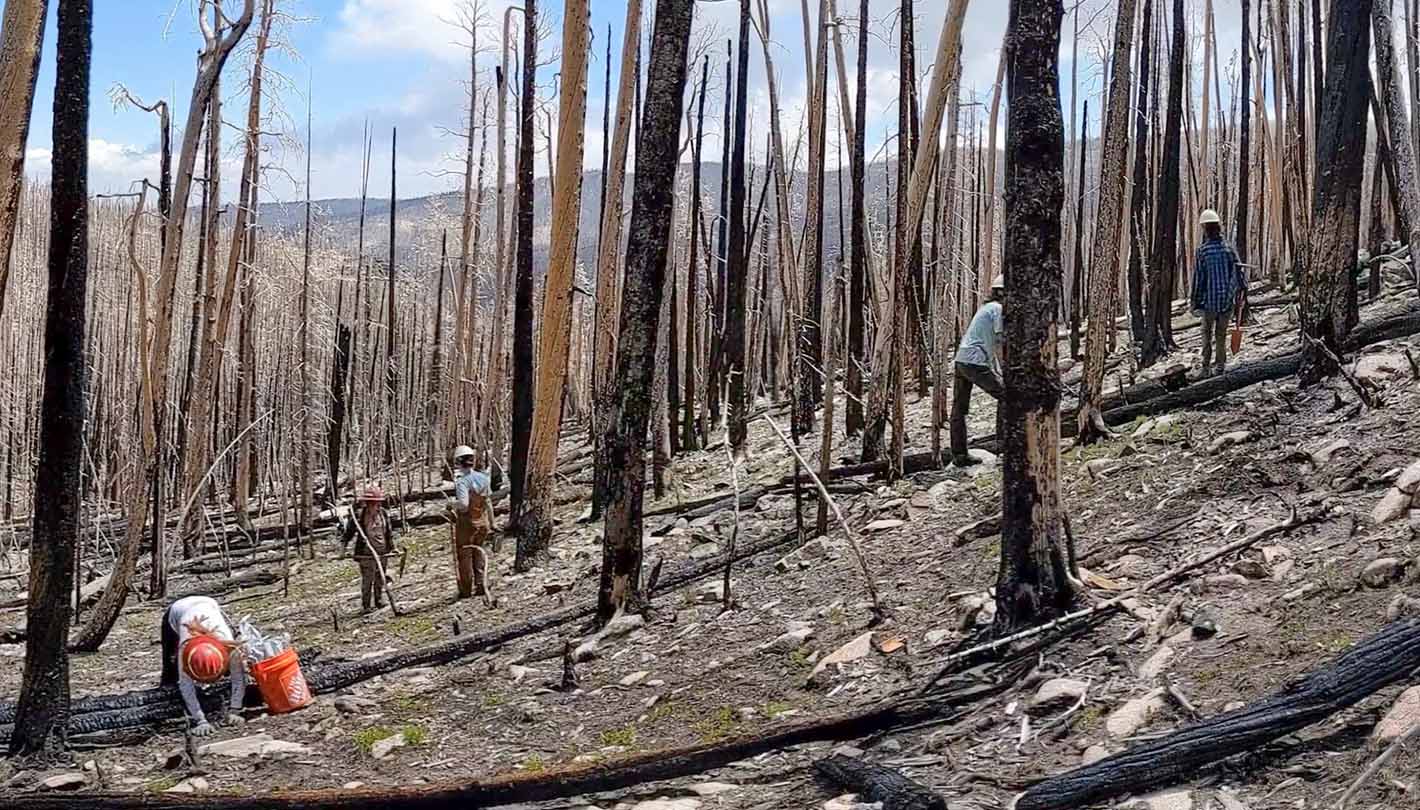
As a professional paper-pusher, I didn’t expect to get to climb trees for work.
I’m a writer for the USDA Forest Service. My job is to sit behind a keyboard, write stories, respond to emails, and navigate computer systems. I love this work and my coworkers but sometimes feel stuck in a rut.
The benefit of doing administrative work for an agency with such a broad and fascinating mission is that you can participate in the adventurous work, too.
That’s how this desk jockey found herself dangling from a 50-foot-tall red pine. But why I was there is even more interesting. It ties back to the agency’s need to supply seedlings for reforestation and address the wildfire crisis.
Need for seed
The Forest Service needs conifer seeds. Lots of them.
These seeds are used to grow the seedlings that will be planted in forests damaged by wildfires. More seeds are needed now than ever because of the unprecedented extent of wildfires in recent years. There are plenty of trees around the country from which to collect, but not enough people to do the collecting. This is partly due to the nature of the conifer seeds.
Conifers produce tiny seeds in cones, which usually grow at the top of the trees on the tips of branches, that are sometimes long, sweeping and massive. For many pine species, the cones burst open while still on the branches, spreading seeds across the forest floor. This is a great mechanism for natural seed dispersal, but it makes seed collection difficult.
Collectors must harvest the seeds from the high-up branches before the cones open, which requires climbing the trees with ropes, harnesses, and pulleys. There is only a one-to-two-week window each year when the seeds are ripe enough to be picked but haven’t been scattered. And there aren’t enough contractors or qualified Forest Service personnel available to collect the needed seeds in that short window.
To address this, the Forest Service trains personnel from all career fields to safely climb trees and collect cones. When the seeds are ripe, these certified tree climbers temporarily step away from their regular duties, travel to a forest, and climb trees for two weeks, collecting cones for seed.
Becoming a Forest Service tree climber
The Forest Service trains employees from federal, state, and local government agencies as well as tribes and university research personnel through Tree Climbing Workshops under the National Tree Climber Program.
Tree Climbing Workshops are offered annually by trainers in each Forest Service region. I trained on the Huron-Manistee National Forest in beautiful northern Michigan.
“There are two ways to tie a knot,” said Paul Valento, a Forest Service master instructor. “The right way. And the wrong way.”
This drew a chuckle from our class of eight trainee climbers. Of course, Valento discovered a third way to tie a knot when he saw my first tangled mess.
“That knot’s not wrong,” said Valento. “It’s horribly wrong!”
With practice and patience, all the trainees’ knot-tying skills improved. Even mine.
The instructors were sometimes stern, yet professional, with a tension-breaking sense of humor. It was a perfect balance for learning skills that, if done wrong, could break a limb - and I’m not talking about the tree.
“Go slow. Take your time,” said Brian Stearns, a Forest Service tree climbing instructor. “Double and triple-check everything.”
After an information-packed morning classroom session, we were already up in the trees on the first day. By the third day of climbing, we were more confident with the equipment and our own capabilities.
The workshop covered:
Tree hazard assessment.
Rope, webbing, and equipment use, care, and safety.
Knots. Lots of knots.
Climbing and descent techniques.
Moving rope systems, stationary rope systems, and throw lines.
Rescue techniques.

It was a lot of material to learn in a few short days, but the trainees persevered.
“So far as the students go, as a group I felt the enthusiasm to learn was really high,” said climbing instructor Timothy Donohoe. "They had positive attitudes and were eager to learn as much as possible in the course.”
The trainees were all Forest Service personnel and represented a mix of professions, social backgrounds, generations, and prior tree-climbing experience. Three trainees represented the Oconto River Seed Orchard in Wisconsin. Rosa Sanchez works as a plant biological science technician there. Desi Panek and Eric Willman both serve there on the Genetics Strike Team. Four trainees were local to the Huron-Manistee National Forest, including multi-resource technician Niki Shugart. Then there was me, a public affairs specialist for the Washington, D.C. office, who works remotely from my home office in Michigan.
“It’s great to see multiple programs participating to develop a skillset that relates to so many of the programs of the Forest Service,” said Donohoe. “There are applications of tree climbing that assist botany, wildlife, timber, recreation, and fire, just to name a few.”
The Forest Service Tree Climbing Workshop is excellent experience for those who are physically inclined, okay with heights, and willing to learn. With the shortage of people available to collect seeds, tree climber certification is available to any federal, state, and local government employee, regardless of their day-to-day career field. Human resources staff, financial officers, firefighters, scientists, administrative assistants, and others can take the course to join the effort. They only need to be available for occasional two-week assignments collecting seeds on a nearby Forest.
“Tree climbing classes are my favorite to be a part of because all of the students are really invested and volunteered to be here,” said Donohoe. “I am excited that we trained another round of passionate climbers to continue to build the tree climbing program.”
Join us
For more information about the National Tree Climbing program or to sign up for a Tree Climbing Workshop, visit fs.usda.gov/treeclimbing.
State, local, tribal, and university organizations should contact James (Brock) Mayo at james.mayo@usda.gov for information on how to get involved in Forest Service Tree Climbing Workshops and its seed collection program.
Can you believe we can take time away from the desk and get paid to climb trees? As a Forest Service employee, I can. And my inner 12-year-old self approves.
Let’s climb a tree!






